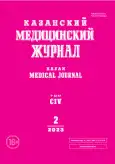Оценка риска развития функциональных нарушений сердечно-сосудистой системы у молодых людей в возрасте 18–25 лет
- Авторы: Аминова О.С.1, Тятенкова Н.Н.2, Мелентьев А.В.3
-
Учреждения:
- Ярославский государственный медицинский университет
- Ярославский государственный университет им. П.Г. Демидова
- Федеральный научный центр гигиены им. Ф.Ф. Эрисмана
- Выпуск: Том 104, № 2 (2023)
- Страницы: 176-182
- Раздел: Теоретическая и клиническая медицина
- Статья получена: 14.07.2022
- Статья одобрена: 18.11.2022
- Статья опубликована: 26.03.2023
- URL: https://kazanmedjournal.ru/kazanmedj/article/view/109328
- DOI: https://doi.org/10.17816/KMJ109328
- ID: 109328
Цитировать
Аннотация
Актуальность. В последние годы среди молодёжи увеличивается доля лиц, имеющих функциональные нарушения и заболевания сердечно-сосудистой системы, в формировании которых важную роль играют поведенческие факторы риска.
Цель. Оценить риск развития функциональных нарушений у молодёжи 18–25 лет в зависимости от социального статуса и образа жизни.
Материал и методы исследования. Проведено обсервационное одномоментное неконтролируемое исследование, объектом которого была молодёжь в возрасте 18–25 лет (1978 человек). Исследуемая выборка поделена на четыре группы: работающие (n=200) и учащиеся (n=313) юноши, работающие (n=526) и учащиеся (n=939) девушки. Для оценки относительного сердечно-сосудистого риска группы делили по социальному статусу, для оценки нарушения адаптационных возможностей — по наличию поведенческого фактора риска. Сравнение независимых групп выполняли с помощью критерия Манна–Уитни. Тестирование нулевых гипотез об отсутствии различий между долями осуществляли с использованием критерия χ2 и расчётом отношения шансов.
Результаты. Относительный сердечно-сосудистый риск выявлен у 21,8% молодёжи. Шансы возникновения риска выше у юношей по сравнению с девушками (р <0,001), у работающей молодёжи по сравнению с учащейся (р <0,001). Шансы снижения адаптационных возможностей сердечно-сосудистой системы выше у курящих юношей в 2,1 раза (p <0,001) и курящих девушек в 2,6 раза (p <0,001) по сравнению с некурящими респондентами. У юношей с чрезмерным употреблением алкоголя, у девушек с нерегулярным питанием и низкой физической активностью чаще были отмечены случаи напряжения механизмов адаптации сердечно-сосудистой системы (в 1,8; 1,4 и 1,7 раза соответственно) по сравнению с группами контроля.
Вывод. Риск развития функциональных нарушений чаще встречался у юношей по сравнению с девушками, у работающих — по сравнению с учащимися; курение сигарет у лиц обоего пола, употребление алкоголя у юношей, нерегулярное питание и низкая физическая активность у девушек способствовали снижению резервных возможностей системы кровообращения.
Полный текст
Об авторах
Ольга Сергеевна Аминова
Ярославский государственный медицинский университет
Автор, ответственный за переписку.
Email: o.s.aminova@ya.ru
ORCID iD: 0000-0002-6577-6278
Scopus Author ID: 57214080442
ResearcherId: GLV-1195-2022
ст. препод., каф. общей гигиены с экологией
Россия, г. Ярославль, РоссияНаталия Николаевна Тятенкова
Ярославский государственный университет им. П.Г. Демидова
Email: tyat@bk.ru
ORCID iD: 0000-0001-8934-9986
докт. биол. наук, проф., зав. каф., каф. физиологии человека и животных
Россия, г. Ярославль, РоссияАндрей Владимирович Мелентьев
Федеральный научный центр гигиены им. Ф.Ф. Эрисмана
Email: amedik@yandex.ru
ORCID iD: 0000-0002-1074-0841
канд. мед. наук, вед.науч.сотруд.
Россия, г. Мытищи, РоссияСписок литературы
- Гречкина Л.И. Оценка показателей гемодинамики как маркёров потенциального риска заболеваний сердечно-сосудистой системы у юношей с разным типом саморегуляции кровообращения. Анализ риска здоровью. 2019;(1):118–124. doi: 10.21668/health.risk/2019.1.13.
- Кретова И.Г., Ведясова О.А., Комарова М.В., Ширяева О.И. Анализ и прогнозирование резервных возможностей организма студентов по параметрам вариабельности сердечного ритма. Гигиена и санитария. 2017;96(6):556–561. doi: 10.18821/0016-9900-2017-96-6-556-561.
- Паспорт приоритетного проекта «Формирование здорового образа жизни». http://static.government.ru/media/files/Soj3PKR09Ta9BAuW30bsAQpD2qTAI8vG.pdf (дата обращения: 03.07.2022).
- Милушкина О.Ю., Маркелова С.В., Скоблина Н.А., Татаринчик А.А., Федотов Д.М., Королик В.В., Аль-Сабунчи А.А. Особенности образа жизни современной студенческой молодёжи. Здоровье населения и среда обитания — ЗНиСО. 2018;(11):5–8. doi: 10.35627/2219-5238/2018-308-11-5-8.
- Tabish SA. Lifestyle diseases: Consequences, characteristics, causes and control. J Cardiol Curr Res. 2017;9(3):00326. doi: 10.15406/jccr.2017.09.00326.
- Драпкина О.М., Концевая А.В., Калинина А.М., Авдеев С.Н., Агальцов М.В., Александрова Л.М., Анциферова А.А., Аронов Д.М., Ахмеджанов Н.М., Баланова Ю.А., Балахонова Т.В., Бернс С.А., Бочкарев М.В., Бочкарева Е.В., Бубнова М.Г., Будневский А.В., Гамбарян М.Г., Горбунов В.М., Горный Б.Э., Горшков А.Ю., Гуманова Н.Г., Дадаева В.А., Дроздова Л.Ю., Егоров В.А., Елиашевич С.О., Ершова А.И., Иванова Е.С., Имаева А.Э., Ипатов П.В., Каприн А.Д., Карамнова Н.С., Кобалава Ж.Д., Конради А.О., Копылова О.В., Коростовцева Л.С., Котова М.Б., Куликова М.С., Лавренова Е.А., Лищенко О.В., Лопатина М.В., Лукина Ю.В., Лукьянов М.М., Маев И.В., Мамедов М.Н., Маркелова С.В., Марцевич С.Ю., Метельская В.А., Мешков А.Н., Милушкина О.Ю., Муканеева Д.К., Мырзаматова А.О., Небиеридзе Д.В., Орлов Д.О., Поддубская Е.А., Попович М.В., Поповкина О.Е., Потиевская В.И., Прозорова Г.Г., Раковская Ю.С., Ротарь О.П., Рыбаков И.А., Свиряев Ю.В., Скрипникова И.А., Скоблина Н.А., Смирнова М.И., Старинский В.В., Толпыгина С.Н., Усова Е.В., Хайлова Ж.В., Шальнова С.А., Шепель Р.Н., Шишкова В.Н., Явелов И.С., Марданов Б.У. Профилактика хронических неинфекционных заболеваний в Российской Федерации. Национальное руководство 2022. Кардиоваскулярная терапия и профилактика. 2022;21(4):3235. doi: 10.15829/1728-8800-2022-3235.
- Кардангушева А.М., Шугушева З.А., Бекулова И.Х., Сантикова Л.В. Распространённость отдельных факторов риска неинфекционных заболеваний среди лиц молодого возраста. Профилактическая медицина. 2017;20(6):52–55. doi: 10.17116/profmed201720652-55.
- Митрохин О.В., Матвеев А.А., Ермакова Н.А., Белова Е.В. Оценка риска возникновения алиментарно-зависимых заболеваний студентов в связи с условиями питания. Анализ риска здоровью. 2019;(4):69–76. doi: 10.21668/health.risk/2019.4.07.
- Лебедева-Несевря Н.А., Елисеева С.Ю. Оценка риска, связанного с воздействием поведенческих факторов на здоровье работающего населения России. Здоровье населения и среда обитания — ЗНиСО. 2018;(5):8–11. doi: 10.35627/2219-5238/2018-302-5-8-11.
- Баевский Р.М., Береснева А.П. Оценка адаптационных возможностей организма и риск развития заболеваний. М.: Медицина; 1997. 265 с.
- Fiala J, Sochor O, Klimusová H, Homolka M. Alcohol consumption in population aged 25–65 years living in the metropolis of south Moravia, Czech Republic. Cent Eur J Public Health. 2017;25(3):191–199. doi: 10.21101/cejph.a4481.
- Шаповалова Э.Б., Максимов С.А., Артамонова Г.В. Половые и гендерные различия сердечно-сосудистого риска. Российский кардиологический журнал. 2019;24(4):99–104. doi: 10.15829/1560-4071-2019-4-99-104.
- Urban NB, Kegeles LS, Slifstein M, Xu X, Martinez D, Sakr E, Castillo F, Moadel T, O’Malley SS, Krystal JH, Abi-Dargham A. Sex differences in striatal dopamine release in young adults after oral alcohol challenge: A positron emission tomography imaging study with [11C]raclopride. Biol Psychiatry. 2010;68(8):689–696. doi: 10.1016/j.biopsych.2010.06.005.
- Карамнова Н.С., Максимов С.А., Шальнова С.А., Швабская О.Б., Драпкина О.М. Кардиопротективный тип питания: распространённость, ассоциации и резервы профилактики. Российский кардиологический журнал. 2020;25(6):32–38. doi: 10.15829/1560-4071-2020-3769.
- Гришан М.А. Физиологические последствия гиподинамии для организма человека. Журнал научных статей. Здоровье и образование в XXI веке. 2018;20(12):70–73. EDN: YPUJZB.
Дополнительные файлы







